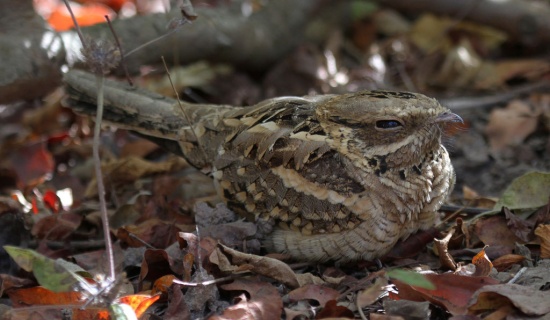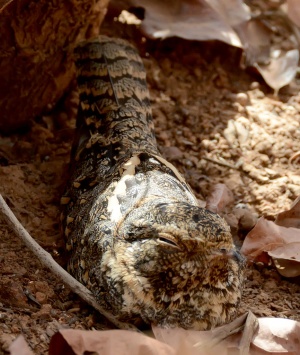- Caprimulgus climacurus
Identification
Length 28-43 cm (11-17 in). Small-bodied with a long tail.
Sexually dimorphic.
Variable in colour ranging from pale brown, brown and greyish-brown to sandy-buff.
- Upperparts and wing-coverts generally greyish-brown, finely streaked brown
Male
- White line across forewing
- Broad tawny or buff nuchal collar
- White throat patch
- Pale brown underparts, speckled and barred pale buff, becoming buff thinly barred brown on belly and flanks
- Broad white band across five outermost primaries and white trailing edge to inner wing
- Tail graduated, central pair longest, outer tail feathers edged and tipped white
- Bill brown, legs and feet brownish
Female:
- Buff or buffish-white line across forewing
- Buffish-white wing band and buff or buffish-white trailing edge to inner wing
- Sshorter-tailed with outer feathers edged and tipped buff
- Iris brown
Immature similar to adult female but paler.
Variations
- Subspecies nigricans distinctive, generally blackish, male often longer-tailed
- Subspecies sclateri more rufous, but variable in colour.
Similar Species
Has notably longer tail than Slender-tailed Nightjar and Square-tailed Nightjar, and is generally paler.
Distribution
Africa: found from Senegambia to Ethiopia, Uganda and DRC.
Taxonomy
Subspecies
Caprimulgus climacurus has three subspecies:[1]:
- C. c. climacurus
- Mauritania to Sudan, western Ethiopia and eastern DRC
- C. c. sclateri
- C. c. nigricans
- Eastern Sudan
Habitat
A wide variety of different habitats, from arid semi-desert through to savanna and clearings in lowland forest.
Behaviour
Diet
Their diet consists of beetles, winged termites, moths, mantids, bugs, ants and grasshoppers. They feed in flight.
Vocalisation
Rapid churring.
References
- Clements, J. F., T. S. Schulenberg, M. J. Iliff, D. Roberson, T. A. Fredericks, B. L. Sullivan, and C. L. Wood. 2017. The eBird/Clements checklist of birds of the world: v2017, with updates to August 2017. Downloaded from http://www.birds.cornell.edu/clementschecklist/download/
- Sinclair, I and P Ryan. 2003. Birds of Africa South of the Sahara. Princeton: Princeton Univ. Press. ISBN 978-0691118154
- Handbook of the Birds of the World Alive (retrieved May 2018)
Recommended Citation
- BirdForum Opus contributors. (2024) Long-tailed Nightjar. In: BirdForum, the forum for wild birds and birding. Retrieved 9 November 2024 from https://www.birdforum.net/opus/Long-tailed_Nightjar
External Links
GSearch checked for 2020 platform.1





